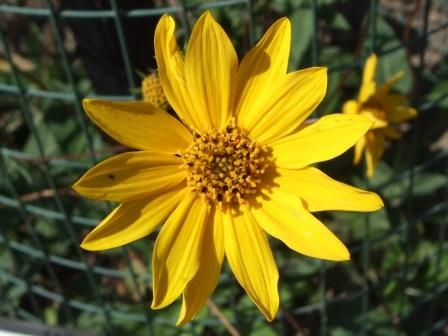Fewleaf Sunflower
(Helianthus occidentalis)
Fewleaf Sunflower (Helianthus occidentalis)
/
/

DDennisM
CC BY 3.0
Image By:
DDennisM
Recorded By:
Copyright:
CC BY 3.0
Copyright Notice:
Photo by: DDennisM | License Type: CC BY 3.0 | License URL: https://creativecommons.org/licenses/by/3.0 | Uploader: DDennisM | Publisher: Wikimedia Commons | Title: Helianthus_occidentalis_compressed.JPG | Notes: |



















































Estimated Native Range
Summary
Helianthus occidentalis, commonly known as Fewleaf Sunflower, is a deciduous perennial herb native to prairie openings, dry woods, and savannas in the East-Central United States. It is distinguished by its sparse leaves, which are primarily concentrated around the lower part of the stem. This sunflower species typically grows to heights of 2 to 5 feet (60–150 cm) and produces one to several yellow flower heads from late summer to early fall. Each head features 8-14 ray florets encircling more than 50 disc florets, offering a modest yet attractive display.
The Fewleaf Sunflower is valued for its adaptability to a range of soil conditions and its drought tolerance, making it a suitable choice for native plant gardens, prairie restorations, and wildflower meadows. Its bright yellow flowers attract pollinators, while its seeds provide food for birds. Gardeners appreciate its low maintenance requirements and its ability to thrive in full sun with minimal water once established. It is also used for cut flowers due to its long stems and cheerful blooms. However, it can be susceptible to powdery mildew and rust, especially in humid conditions. To prevent these issues, ensure good air circulation and avoid overhead watering.CC BY-SA 4.0
The Fewleaf Sunflower is valued for its adaptability to a range of soil conditions and its drought tolerance, making it a suitable choice for native plant gardens, prairie restorations, and wildflower meadows. Its bright yellow flowers attract pollinators, while its seeds provide food for birds. Gardeners appreciate its low maintenance requirements and its ability to thrive in full sun with minimal water once established. It is also used for cut flowers due to its long stems and cheerful blooms. However, it can be susceptible to powdery mildew and rust, especially in humid conditions. To prevent these issues, ensure good air circulation and avoid overhead watering.CC BY-SA 4.0
Plant Description
- Plant Type: Herb
- Height: 2-4 feet
- Width: 1.5-2 feet
- Growth Rate: Moderate
- Flower Color: Yellow
- Flowering Season: Summer, Fall
- Leaf Retention: Deciduous
Growth Requirements
- Sun: Full Sun
- Water: Low, Medium
- Drainage: Fast, Medium
Common Uses
Bee Garden, Bird Garden, Butterfly Garden, Deer Resistant, Drought Tolerant, Erosion Control, Rabbit Resistant, Showy Flowers, Water Garden
Natural Habitat
Prairie openings, dry woods, and savannas in the East-Central United States
Other Names
Common Names: Western Sunflower , Naked-Stemmed Sunflower , Wenigblättrige Sonnenblume
Scientific Names: Helianthus occidentalis , Helianthus occidentalis var. occidentalis
GBIF Accepted Name: Helianthus occidentalis Riddell